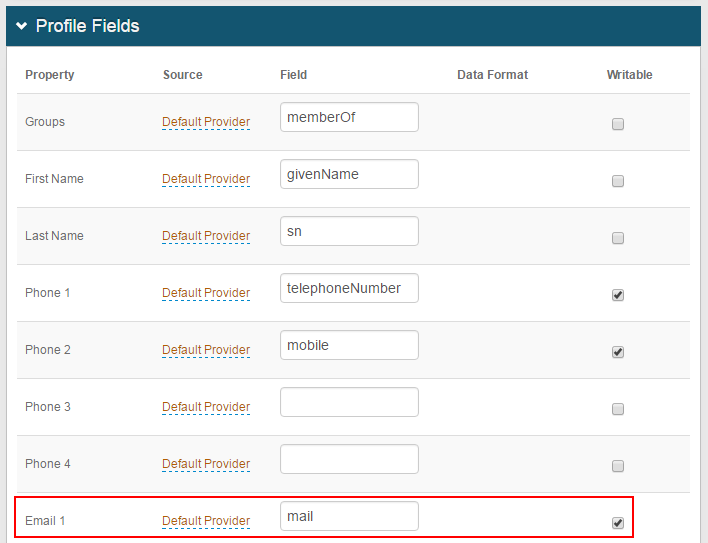MaaS360 (SP-initiated) Integration Guide
Introduction
Use this guide to enable Service Provider (SP)-initiated Multi-Factor Authentication and Single Sign-on (SSO) access via SAML to MaaS360.
Prerequisites
1. Obtain an MaaS360 Mobile Device Management account with administrator permissions
2. Create a New Realm for the MaaS360 integration
3. Configure the following tabs in the Web Admin before configuring the Post Authentication tab:
Overview – the description of the realm and SMTP connections must be defined
Data – an enterprise directory must be integrated with SecureAuth IdP
Workflow – the way in which users will access this application must be defined
Multi-Factor Methods – the Multi-Factor Authentication methods that will be used to access this page (if any) must be defined
SecureAuth IdP Configuration Steps
Data
 |
1. In the Profile Fields section, map the directory field that contains the user's email address to the Email 1 Property
Warning
Click Save once the configurations have been completed and before leaving the Data page to avoid losing changes
Post Authentication
 |
2. Select SAML 2.0 (SP Initiated) Assertion from the Authenticated User Redirect dropdown in the Post Authentication tab in the Web Admin
3. An unalterable URL will be auto-populated in the Redirect To field, which will append to the domain name and realm number in the address bar (Authorized/SAML20SPInit.aspx)
4. A customized post authentication page can be uploaded, but it is not required
User ID Mapping
 |
5. Select the SecureAuth IdP Property that corresponds to the directory field that contains the email address (Email 1)
6. Select urn:oasis:names:tc:SAML:1.1:nameid-format:unspecified from the Name ID Format dropdown (default)
7. Select True from the Encode to Base64 dropdown
SAML Assertion / WS Federation
 |
8. Set the WSFed Reply To / SAML Target URL to https://m3.maas360.com/login?custID=### – in which '###' represents the customer ID number
9. Set the SAML Consumer URL to https://sso.connect.pingidentity.com/sso/sp/ACS.saml2
10. Set the WSFed / SAML Issuer to a Unique Name that will be shared with MaaS360
The WSFed / SAML Issuer must match exactly on the SecureAuth IdP side and the MaaS360 side
11. Set the SAML Recipient to https://m3.maas360.com/login?custID=###
12. Set the SAML Audience to https://sso.connect.pingidentity.com
13. Set the SP Start URL to enable SSO and to redirect users appropriately to access MaaS360
For example, the SP Start URL would be https://m3.maas360.com/login?custID=###
14. Set the SAML Offset Minutes to compensate for time differences between devices
15. Set the SAML Valid Hours to limit for how long the SAML assertion is valid
 |
16. Leave the Signing Cert Serial Number as the default value, unless there is a third-party certificate being used for the SAML assertion
If using a third-party certificate, click Select Certificate and choose the appropriate certificate
17. Download the Assertion Signing Certificate which is used in the MaaS360 Configuration Steps
18. Provide the Domain in order to Download the Metadata File to send to MaaS360 (if required)
Warning
Click Save once the configurations have been completed and before leaving the Post Authentication page to avoid losing changes
MaaS360 Configuration Steps
 |
1. Log on the MaaS360 site as an Administrator and access Setup > Login Settings to configure authentication for Administrators
2. Enable Configure Federated Single Sign-on
3. Select Use SAML for Single Sign-on
4. Set Identity Provider Name to the Unique Name entered in step 10 of the SecureAuth IdP Configuration settings
5. Set the Sign-in Page URL to include the Fully Qualified Domain Name – e.g. https://fqdn.appliance.com
6. For Verification Certificate, click Browse... to search and find the Assertion Signing Certificate downloaded from the SecureAuth IdP MaaS360 realm
7. Enter the Notification Email Address to be used
8. Enable Allow existing Administrators to use portal credentials as well
9. Save the configuration